On the Origins of New Forms of Life
2.4: Hybrid Populations
(Continued from the previous page)
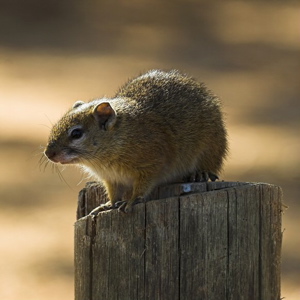 Smith's Bush Squirrel
Smith's Bush SquirrelParaxerus cepapi
(click to enlarge)
Credit: Nico Conradie
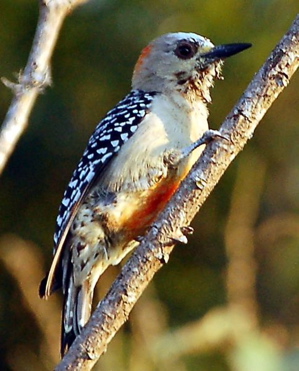 Red-crowned Woodpecker
Red-crowned WoodpeckerMelanerpes rubricapillus
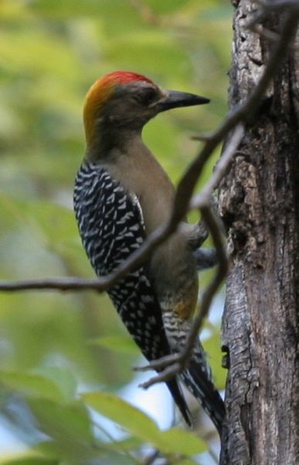 Hoffmann's Woodpecker
Hoffmann's WoodpeckerMelanerpes hoffmannii
Credit: Emmanuel Miranda
Naturally occurring hybrid populations have characteristic traits that distinguish them from pure populations unaffected by hybridization. Certain of these traits are important in stabilization theory and will therefore be briefly discussed in this section.
Hybrid Zones. A geographic region where genetically distinct natural populations come into contact and hybridize is known as a hybrid zone (a hybrid zone, especially a wide hybrid zone, can also be viewed as a naturally occurring hybrid population). Hybrid zones are found in all major groups of sexual organisms. The pure parental populations on opposite sides of a hybrid zone may differ with respect to almost any type of characteristic — appearance, behavior, physiology, or call.
Many hybrid populations exhibit a continuum of variation, spanning the gap between parental types. Within a population composed of partially fertile hybrids, the hybrids occupying regions closer to a particular parental type tend to be more similar to that parent. For example, a broad hybrid population between Smith's Bush Squirrel (Paraxerus cepapi) and the Red Bush Squirrel (P. palliatus) extends from southern Tanzania through Mozambique and Malawi to northeastern South Africa (Kingdon 1974b). Hybrid squirrels occurring near the range of Smith's Bush Squirrel have almost all the traits of P. cepapi. Those occurring near the Red Bush Squirrel have almost all those of P. palliatus. In intermediate regions there are squirrels of all intermediate types. Similarly in southwestern Papua New Guinea there is a hybrid zone between the Greater Bird of Paradise (Paradisaea apoda) and the Raggiana Bird of Paradise (P. raggiana). In this zone, birds vary geographically in appearance, from very similar to the Raggiana in the east to almost identical to the Greater in the west. In South America (Cruzeiro do Sul, Brazil), there is a hybrid zone between two primates, the Saddle-backed and White-mantled tamarins (Saguinus fuscicollis and S. melanoleucus), in which, again, hybrids of all degrees of intermediacy occur.
Intergradation. Natural hybridization is often referred to as "intergradation," especially in cases where there is clinal variation. A cline is a graded series of differences exhibited within a population (usually along a geographic line or across a region of environmental transition). In eastern North America, for example, white-tailed deer (Odocoileus virginianus) decline gradually in size from north to south. Intergradation came to be applied to hybridization between populations since the variation in such cases is commonly clinal in nature. Hybrid populations often have a very broad geographic distribution. The rate of change across such a population may be very gradual. Thus, four South American toucans often treated as species (Ramphastos ariel, R. citreolaemus, R. culminatus, and R. vitellinus) are recognizable as types within their respective ranges, but are separated by huge hybrid populations more than a thousand kilometers wide. Under such circumstances use of the term intergradation makes sense because the populations merge gradually, one with the other, through a continuous series of intermediate individuals. However, the word is also often applied in the case of populations that interbreed regularly but maintain a sharp discontinuous boundary where they interface. Hoffmann's Woodpecker (Melanerpes hoffmannii) and the Red-crowned Woodpecker (M. rubricapillus) each have extensive ranges, but they are often said to "intergrade" in Costa Rica because they hybridize there. In this case there is interbreeding without a gradual transition. The characteristics of these two birds have remained sharply distinct and the hybrid zone is quite narrow. It is misleading to use intergrade instead of hybridize to describe populations that are sharply distinct because such populations might be supposed erroneously to blend gradually via a wide hybrid population when they don't. In this book, therefore, the word hybridization is used to refer to interbreeding of all kinds, whether or not it results in the production of a broad cline between the affected populations.
Compound Hybrid Zones. Compound hybrids, produced from crosses between multiple types of organisms, occur naturally in compound hybrid zones, contact zones where multiple types interbreed. For example, three hummingbirds — the Purple-throated, White-throated, and Grey-tailed mountain-gems (Lampornis calolaema, L. castaneoventris, and L. cinereicauda) — have a three-way zone in southern Central America. In eastern Australia, five other birds, sittellas of the genus Daphoenositta, each distinct in appearance, hybridize where they come into contact along five lines radiating from a juncture in central Queensland. The birds in the hybrid population near this center, may have ancestry involving all five different forms. In eastern Africa there are compound hybrid zones between distinct types of giraffes. Though these various forms are now usually treated as races of a single species (Giraffa camelopardalis), Dagg (1962) says they were treated as separate species until they were found to hybridize.
Mobile Zones. Many natural hybrid zones are mobile. The hybrid zone in eastern North America between the Golden-winged and Blue-winged warblers (Vermivora chrysoptera and V. pinus) moves every year, with V. pinus slowly taking over territory from the V. chrysoptera.
Movement has been reported in zones between even relatively sedentary animals such as fossorial insectivores and rodents. For example, Benedict (1997, 1999a, 1999b) reported on a narrow hybrid zone in southern Nebraska (central U.S.) between the Northern Short-tailed Shrew (Blarina brevicauda) and Elliot's Short-tailed Shrew (B. hylophaga). Benedict says (1999a: 135) that this hybrid zone has undergone rapid movement. For example, at one site it shifted 2.4 kilometers to the south in 22 months. Benedict says his survey showed that the zone often coincided with partial barriers to dispersal (e.g. streams, highways). For example, in Adams County, it straddled West 12th Street between the towns of Hastings and Juniata. After its rapid southward shift, it stabilized thereafter on Highway 34. While surveying avian and mammalian hybrid populations, the writer (McCarthy) has noted many other cases where the zones seem to have stabilized along a dispersal barrier. For example, contact between the House Sparrow (Passer domesticus) and the Italian Sparrow (P. italiae) is blocked by the Adriatic Sea and, for the most part by the Alps, but hybrid populations do occur in those mountains in low elevation passes. Gilliard (1959: 17) discusses a low pass through the otherwise high cordillera dividing northern and southern New Guinea. Mayr and Gilliard (1954: 354) named this pass "Hybrid Gap" because a variety of different types of avian hybrids had been discovered there.
Split Ranges. Since movement of a hybrid zone results from one of the hybridizing forms taking over range from the other, there is always the potential for the receding form's range to be split. For example, the advancing zone might reach a coastline, mountain range, or river. Under such circumstances, the distribution of the receding form would become discontinuous, splitting on either side of the range of the advancing one. This process probably accounts for many situations where one organism has two ranges separated by the range of another. Examples are such hybridizing pairs as the Turquoise and Collared jays (Cyanolyca turcosa and C. viridicyana) of the Peruvian Andes, or the Hooded and Carrion crows (Corvus cornix and C. corone) of Eurasia. In the latter case, the one of crow hybridization, there are two hybrid zones some 4,000 kilometers apart, one in western Europe, the other in Asia. The range of the Hooded Crow lies in between.
Extinction. Hybridization in some cases can lead to the extinction of one of the hybridizing forms. Extinction by this means is most often observed when interbreeding is extensive and one hybridizing type is far outnumbered by the other. The Rusty Grebe (Tachybaptus rufolavatus) was confined to Lake Alaotra on Madagascar, where it hybridized so intensely with the invading Little Grebe (T. ruficollis) that it seems already to have ceased to exist as a separate genetic entity. Two other birds, the Yellow-throated Miner (Manorina flavigula), and Black-eared Miner (M. melanotis) hybridize extensively in southeastern Australia. Contact occurs just east of Adelaide. Backcrossing results in a continuum of hybrids, with the darkest almost indistinguishable from the Black-eared Miner, and the palest almost like the Yellow-throated. M. flavigula ranges over most of Australia, while M. melanotis has a restricted range. Virtually no pure flocks of the latter remain.
Expansion of a new form of hybrid origin that is fitter than its parents can also lead to local extinction of its progenitors. An increasing number of well-documented examples are becoming available of natural hybrids that are adaptively superior to their parents (in addition to the cases already discussed see citations listed in note ). Thus, after the rusty crayfish (Orconectes rusticus) was introduced to Wisconsin and Michigan (northern United States), it hybridized with the native O. propinquus (northern clearwater crayfish). Perry et al. (2001) found that the hybrids were superior to both parents in competing for limited food resources and that hybridization consequently poses a threat to O. propinquus. A similar case is that of the hybrid between the Mallard (Anas platyrhynchos) and the Pacific Black Duck (A. superciliosa), discussed in Section 4, which is displacing its parents from New Zealand . Hegde et al. (2006) recently showed that extensive hybridization between two radishes that have become naturalized in California, Raphanus sativus (cultivated radish) and R. raphanistrum (jointed charlock), have produced hybrids that are so fit that they have brought on the local extinction of the parents.
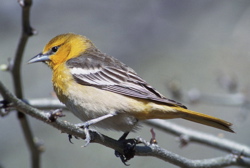
|
|
Baltimore Oriole Icterus galbula (Enlarge image) |
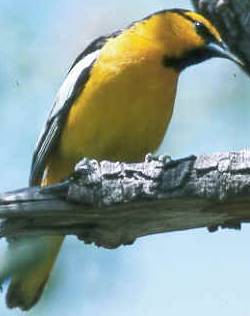
|
|
Bullock's Oriole Icterus bullockii |
Wide Zones and Hybrid Populations. When hybrids occur only at low frequency, parental populations can overlap broadly without significant genetic consequence. For example, the Mourning Warbler (Oporornis philadelphia) and Canada Warbler (Wilsonia canadensis) have almost identical breeding ranges in Canada and the northeastern United States. But, because there are only a few reports of hybridization between them, the situation appears stable. Levels of hybridization in this case do not appear to be high enough to significantly affect either population. On the other hand, if mixed matings produce progeny at higher rates, and those offspring are more fertile and viable, extensive hybrid populations can arise. Kingdon (1974a: 41, 42-43, 45) discusses a large hybrid population (or broad hybrid zone) in southern Tanzania and northern Mozambique between the Checkered Elephant-Shrew (Rhynchocyon cirnei) and the Black-and-rufous Elephant-Shrew (R. petersi). This zone is so wide that pure parental individuals almost never come into contact to produce ₁ hybrids. In such cases virtually all individuals within the zone are later-generation hybrids. Such is the case with two avian hybrid zones, between Bullock's Oriole (Icterus bullockii) and the Baltimore Oriole (I. galbula), and between the Rose-breasted and Black-headed grosbeaks (Pheucticus ludovicianus and P. melanocephalus) on the Great Plains of North America. Thulin et al. (2006) report similar findings regarding hybrids between the European Hare (Lepus europaeus) and Mountain Hare (L. timidus) in Sweden. Hybrid populations composed solely of later-generation hybrids (where F₁ hybrids are rare or absent) occur in a broad range of organisms.
The width of a hybrid zone depends in part on the viability and fertility of the hybrids. When they are relatively infertile and inviable, the zone will be narrower, all other factors being equal. When they are more fertile/viable, it will be wider. This makes sense—if a hybrid zone is thought of as a population, it would be expected to grow (i.e., get wider) if the hybrids were fitter. Even in crosses where the hybrids are quite fit, a hybrid zone may act to isolate the parental types from each other—the zone is so wide that they are isolated by distance. The extremely wide hybrid zones between Ramphastos toucans (mentioned above) are an example. NEXT PAGE >>
Most shared on Macroevolution.net:
Human Origins: Are we hybrids?
On the Origins of New Forms of Life
Mammalian Hybrids
Cat-rabbit Hybrids: Fact or fiction?
Famous Biologists
Dog-cow Hybrids
Georges Cuvier: A Biography
Prothero: A Rebuttal
Branches of Biology
Dog-fox Hybrids